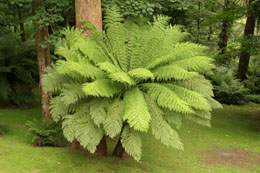The Australian tree fern is a very popular pick when it comes to garden landscaping. The tree has its origin in Australia, hence the name. This Buzzle article discusses the general information regarding its features, habitat, and care.

The Australian tree fern is known by many other names including Cooper's tree fern, scaly tree fern, lacy tree fern, and Cyathea cooperi. The term Cyathea is derived from the Greek word 'kyatheion' that means little cup. This refers to the structure that holds the spores of this tree. The term cooperi was linked to this species in honor of Sir Daniel Cooper (1821-1902), the first Speaker of the Legislative Assembly.
This tree fern is a popular choice of home owners as an ornamental plant. The crown shape formed by the arrangement of the leaves gives the tree a pleasant look. Also, its ability to grow easily without much care has made it a popular name among the hardy tree-ferns. The following sections explain the scientific classification, features, habitat, and caring tips regarding this tree fern.
Scientific Classification
✦ Kingdom: Plantae
✦ Subkingdom: Viridiplantae
✦ Infrakingdom: Streptophyta
✦ Superdivision: Embryophyta
✦ Division: Tracheophyta
✦ Subdivision: Polypodiophytina
✦ Class: Polypodiopsida
✦ Subclass: Polypodiidae
✦ Order: Cyatheales
✦ Family: Cyatheaceae
✦ Species: Cyathea cooperi
Source: Integrated Taxonomic Information System (ITIS)
Physical Features
✦ The Australian tree fern is a medium-to-large sized tree that can grow anywhere between 12 to 40 feet in height. The foliage can spread ranging from 8 to 20 feet. It can be used as an indoor houseplant as well as an outdoor plant. Most likely, a point comes where the dimensions of the plant would exceed the indoor space dedicated to it. Therefore, you'll have to prune it on a regular basis.
✦ This fern tree has a single trunk that can get as thick as 30 cm. You can see trimmed, oval-shaped scaly patterns on the trunk, covered with attractive brown hair having a glossy texture. However, these can cause skin irritation; hence, you must wear gloves while grooming this tree.
✦ The leaves are spirally arranged which gives this fern an aesthetic appeal. The foliage of the tree is evergreen in all the seasons and does not change in falls. The tree does not bear any fruits or flowers. The most attractive physical feature of the Australian tree fern is the unrolled appearance of the leaves at the top of the tree.
Habitat
✦ Rainforests and gullies are the original natural habitats of this tree. Hence, moist climate is most suitable for its growth. It can sustain in dry climates as well, provided the soil remains moist all the time. It cannot tolerate too much of sunlight and hence should be placed in a shady or partially shaded area.
✦ The tree is fast growing and uproots the native plants by forming thick stands. This is because the tree spreads its spores at a very fast pace with the help of wind, and they germinate within a week or so. These spores grow at the underside of the tree leaves.
Care
✦ The plant should never be allowed to dry out. Even if the climate is not moist, ensure that the soil is watered regularly.
✦ It thrives well in temperatures ranging between 65ºF and 80ºF. However, it cannot tolerate sudden changes in the temperature.
✦ You need to fertilize it at regular intervals. Properly rotted animal manures and organic fertilizers will help the Australian tree fern to grow vigorously. Application of good-quality mulches will help the tree get moisture and the much-needed nutrition as well.
✦ The tree usually does not suffer from serious diseases but can be affected by mites, termites, and mealy bugs that can attack its trunk. Hence, it is important to use fertilizers regularly to make it less susceptible to such outbreaks.
✦ You need to repot it every year. Ensure that the soil is fresh and well-drained.
The Australian tree fern is robust, grows easily, and requires very less maintenance; hence making it one of the best ornamental trees for indoor placement and garden landscaping. With the minimal amount of care and maintenance, it would be easy for you to enjoy its lush green presence and experience what it feels to be sitting under the shade of its rich artistic foliage.






 The Australian tree fern is known by many other names including Cooper's tree fern, scaly tree fern, lacy tree fern, and Cyathea cooperi. The term Cyathea is derived from the Greek word 'kyatheion' that means little cup. This refers to the structure that holds the spores of this tree. The term cooperi was linked to this species in honor of Sir Daniel Cooper (1821-1902), the first Speaker of the Legislative Assembly.
The Australian tree fern is known by many other names including Cooper's tree fern, scaly tree fern, lacy tree fern, and Cyathea cooperi. The term Cyathea is derived from the Greek word 'kyatheion' that means little cup. This refers to the structure that holds the spores of this tree. The term cooperi was linked to this species in honor of Sir Daniel Cooper (1821-1902), the first Speaker of the Legislative Assembly.